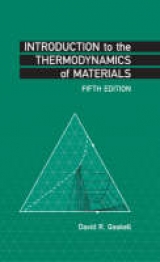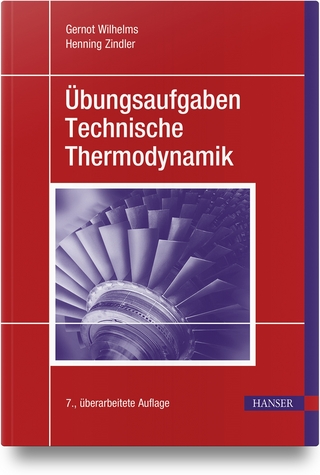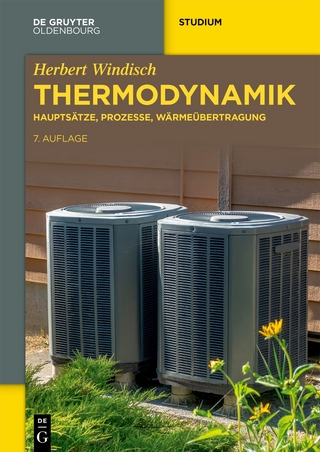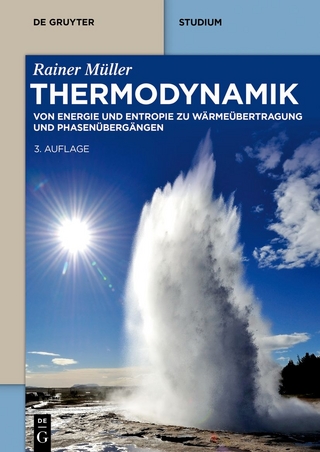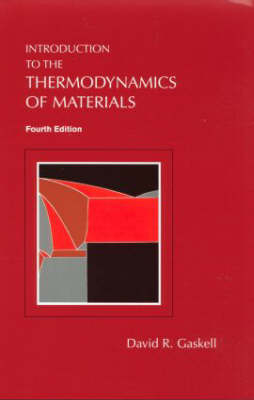
Introduction to the Thermodynamics of Materials, Fifth Edition
Taylor & Francis Inc (Verlag)
978-1-56032-992-3 (ISBN)
- Titel erscheint in neuer Auflage
- Artikel merken
Preface 1. INTRODUCTION AND DEFINITION OF TERMS Introduction The Concept of State Simple Equilibrium The Equation of State of an Ideal Gas The Units of Energy and Work Extensive and Intensive Properties Phase Diagrams and Thermodynamic Components 2. THE FIRST LAW OF THERMODYNAMICS 2.1 Introduction 2.2 The Relationship between Heat and Work 2.3 Internal Energy and the First Law of Thermodynamics 2.4 Constant-Volume Processes 2.5 Constant-Pressure Processes and the Enthalpy H 2.6 Heat Capacity 2.7 Reversible Adiabatic Processes 2.8 Reversible Isothermal Pressure or Volume Changes of an Ideal Gas 2.9 Summary 2.10 Numerical Examples Problems 3. THE SECOND LAW OF THERMODYNAMICS 3.1 Introduction 3.2 Spontaneous or Natural Processes 3.3 Entropy and the Quantification of Irreversibility 3.4 Reversible Processes 3.5 An Illustration of Irreversible and Reversible Processes 3.6 Entropy and Reversible Heat 3.7 The Reversible Isothermal Compression of an Ideal Gas 3.8 The Reversible Adiabatic Expansion of an Ideal Gas 3.9 Summary Statements 3.10 The Properties of Heat Engines 3.11 The Thermodynamic Temperature Scale 3.12 The Second Law of Thermodynamics 3.13 Maximum Work 3.14 Entropy and the Criterion for Equilibrium 3.15 The Combined Statement of the First and Second Laws of Thermodynamics 3.16 Summary 3.17 Numerical Examples Problems 4. THE STATISTICAL INTERPRETATION OF ENTROPY 4.1 Introduction 4.2 Entropy and Disorder on an Atomic Scale 4.3 The Concept of Microstate 4.4 Determination of the Most Probable Microstate 4.5 The Influence of Temperature 4.6 Thermal Equilibrium and the Boltzmann Equation 4.7 Heat Flow and the Production of Entropy 4.8 Configurational Entropy and Thermal Entropy 4.9 Summary 4.10 Numerical Examples Problems 5. AUXILIARY FUNCTIONS 5.1 Introduction 5.2 The Enthalpy H 5.3 The Helmholtz Free Energy A 5.4 The Gibbs Free Energy G 5.5 Summary of the Equations for a Closed System 5.6 The Variation of the Composition and Size of the System 5.7 The Chemical Potential 5.8 Thermodynamic Relations 5.9 Maxwell's Equations 5.10 The Upstairs-Downstairs-Inside-Out Formula 5.11 The Gibbs-Helmholtz Equation 5.12 Summary 5.13 Example of the Use of the Thermodynamic Relations Problems 6. HEAT CAPACITY, ENTHALPY, ENTROPY, AND THE THIRD LAW OF THERMODYNAMICS 6.1 Introduction 6.2 Theoretical Calculation of the Heat Capacity 6.3 The Empirical Representation of Heat Capacities 6.4 Enthalpy as a Function of Temperature and Composition 6.5 The Dependence of Entropy on Temperature and the Third Law of Thermodynamics 6.6 Experimental Verification of the Third Law 6.7 The Influence of Pressure on Enthalpy and Entropy 6.8 Summary 6.9 Numerical Examples Problems 7. PHASE EQUILIBRIUM IN A ONE-COMPONENT SYSTEM 7.1 Introduction 7.2 The Variation of Gibbs Free Energy with Temperature at Constant Pressure 7.3 The Variation of Gibbs Free Energy with Pressure at Constant Temperature 7.4 Gibbs Free Energy as a Function of Temperature and Pressure 7.5 Equilibrium between the Vapor Phase and a Condensed Phase 7.6 Graphical Representation of Phase Equilibria in a One-Component System 7.7 Solid-Solid Equilibria 7.8 Summary 7.9 Numerical Examples Problems 8. THE BEHAVIOR OF GASES 8.1 Introduction 8.2 The P-V-T Relationships of Gases 8.3 Deviations from Ideality and Equations of State for Real Gases 8.4 The van der Waals Gas 8.5 Other Equations of State for Nonideal Gases 8.6 The Thermodynamic Properties of Ideal Gases and Mixtures of Ideal Gases 8.7 The Thermodynamic Treatment of Nonideal Gases 8.8 Summary 8.9 Numerical Examples Problems 9. THE BEHAVIOR OF SOLUTIONS 9.1 Introduction 9.2 Raoult's Law and Henry's Law 9.3 The Thermodynamic Activity of a Component in Solution 9.4 The Gibbs-Duhem Equation 9.5 The Gibbs Free Energy of Formation of a Solution 9.6 The Properties of Raoultian Ideal Solutions 9.7 Nonideal Solutions 9.8 Application of the Gibbs-Duhem Relation to the Determination of Activity 9.9 Regular Solutions 9.10 A Statistical Model of Solutions 9.11 Subregular Solutions 9.12 Summary 9.13 Numerical Examples Problems 10. GIBBS FREE ENERGY-COMPOSITION AND PHASE DIAGRAMS OF BINARY SYSTEMS 10.1 Introduction 10.2 Gibbs Free Energy and Thermodynamic Activity 10.3 The Gibbs Free Energy of Formation of Regular Solutions 10.4 Criteria for Phase Stability in Regular Solutions 10.5 Liquid and Solid Standard States 10.6 Phase Diagrams, Gibbs Free Energy, and Thermodynamic Activity 10.7 The Phase Diagrams of Binary Systems That Exhibit Regular Solution Behavior in the Liquid and Solid States 10.8 Summary 10.9 Numerical Example Problems 11. REACTIONS INVOLVING GASES 11.1 Introduction 11.2 Reaction Equilibrium in a Gas Mixture and the Equilibrium Constant 11.3 The Effect of Temperature on the Equilibrium Constant 11.4 The Effect of Pressure on the Equilibrium Constant 11.5 Reaction Equilibrium as a Compromise between Enthalpy and Entropy 11.6 Reaction Equilibrium in the System SO2(g)-SO3(g)-O2(g) 11.7 Equilibrium in H2O-H2 and CO2-CO Mixtures 11.8 Summary 11.9 Numerical Examples Problems 12. REACTIONS INVOLVING PURE CONSENSED PHASES AND A GASEOUS PHASE 12.1 Introduction 12.2 Reaction Equilibrium in a System Containing Pure Condensed Phases and a Gas Phase 12.3 The Variation of the Standard Gibbs Free Energy Change with Temperature 12.4 Ellingham Diagrams 12.5 The Effect of Phase Transformations 12.6 The Oxides of Carbon 12.7 Graphical Representation of Equilibria in the System Methal-Carbon-Oxygen 12.8 Summary 12.9 Numerical Examples Problems 13. REACTION EQUILIBRIA IN SYSTEMS CONTAINING COMPONENTS IN CONDENSED SOLUTIONS 13.1 Introduction 13.2 The Criteria for Reaction Equilibrium in Systems Containing Components in Condensed Solution 13.3 Alternative Standard States 13.4 The Gibbs Phase Rule 13.5 Binary Systems Containing Compounds 13.6 Graphical Representation of Phase Equilibria 13.7 The Formation of Oxide Phases of Variable Composition 13.8 The Solubility of Gases in Metals 13.9 Solutions Containing Several Dilute Solutes 13.10 Summary 13.11 Numerical Examples Problems 14. PHASE DIAGRAMS FOR BINARY SYSTEMS IN PRESSURE-TEMPERATURE-COMPOSITION SPACE 14.1 Introduction 14.2 A Binary System Exhibiting Complete Mutual Solubility of the Components in the Solid and Liquid States. 14.3 A Binary System Exhibiting Complete Mutual Solubility in the Solid and Liquid States and Showing Minima on the Melting, Boiling, and Sublimation Curves 14.4 A Binary System Containing a Eutectic Equilibrium and Having Complete Mutual Solubility in the Liquid 14.5 A Binary System Containing a Peritectic Equilibrium and Having Complete Mutual Solubility in the Liquid State 14.6 Phase Equilibrium in a Binary System Containing an Intermediate y Phase That Melts, Sublimes, and Boils Congruently 14.7 Phase Equilibrium in a Binary System Containing and Intermediate y Phase That Melts and Sublimes Congruently and Boils Incongruently 14.8 Phase Equilibrium in a Binary System with a Eutectic and One Component That Exhibits Allotropy 14.9 A Binary Eutectic System in Which Both Components Exhibit Allotropy 14.10 Phase Equilibrium at Low Pressure: The Cadmium-Zinc System 14.11 Phase Equilibrium at High Pressure: The Na2O * Al2O3 * 2SiO2 - SiO2 System 14.12 Summary 15. ELECTROCHEMISTRY 15.1 Introduction 15.2 The Relationship between Chemical and Electrical Driving Forces 15.3 The Effect of Concentration on EMF 15.4 Formation Cells 15.5 Concentration Cells 15.6 The Temperature Coefficient of EMF 15.7 Heat Effects 15.8 The Thermodynamics of Aqueous Solutions 15.9 The Gibbs Free Energy of Formation of Ions and Standard Reduction Potentials 15.10 Pourbaix Diagrams 15.11 Summary 15.12 Numerical Examples Problems Appendix A: Selected Thermodynamic and Thermochemical Data Appendix B Exact Differential Equations Appendix C The Generation of Auxiliary Functions as Legendre Transformations
Nomenclatures
Answers
Index
| Erscheint lt. Verlag | 6.3.2003 |
|---|---|
| Zusatzinfo | 375 Illustrations, color |
| Verlagsort | Washington |
| Sprache | englisch |
| Maße | 152 x 229 mm |
| Gewicht | 1134 g |
| Themenwelt | Naturwissenschaften ► Physik / Astronomie ► Thermodynamik |
| Technik ► Maschinenbau | |
| ISBN-10 | 1-56032-992-0 / 1560329920 |
| ISBN-13 | 978-1-56032-992-3 / 9781560329923 |
| Zustand | Neuware |
| Informationen gemäß Produktsicherheitsverordnung (GPSR) | |
| Haben Sie eine Frage zum Produkt? |
aus dem Bereich
